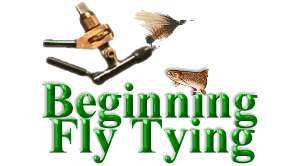There are a lot of tools that pertain
to fly tying. It's amazing how many tools you
can find that are supposedly the "greatest fly
tying tools you'll ever use", but when you buy
them, you can't find a use for them. I've got
a drawer full of "great" tools that don't work
as advertised. It's pretty easy to get duped
by a nice looking ad or a salesman trying to
unload a slow moving product. There are also
a bunch of tools I couldn't do without. Let's
take a look at the essential ones.
One tool you'll use every time you tie a fly
is a bobbin. This little gem holds the thread
and keeps tension on it while you tie the fly.
It has a small tube (some are larger than others)
that the thread runs through. Thank God it's
smaller than my fingers, or I'd never get a small
fly tied.
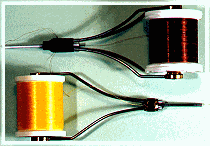
Bobbins come in a variety of sizes and shapes, but
they all perform the same duty. Some have ceramic
tubes the thread runs through, others are just
stainless steel. Some are flared, some are straight
at the end of the tube, and some have mysterious
bends in the frame designed to make them easier to hold.
Some have ceramic or jeweled inserts on the end of the
tube and some have springs that reel up the slack thread
while you use them. Good bobbins never cut the thread
and cheap bobbins almost always cut the thread, so it's
wise to invest in a good bobbin or two. One thing they
all have in common; they all hold the thread and have a
small tube that makes it easier to direct the thread to
the right place on the hook. I have over a dozen ceramic
bobbins pre-loaded with thread on my fly tying
desk at all times.
Good scissors are an absolute necessity for fly tying.
This is another tool you don't want to save money on.
You'll need at least one pair of scissors to start,
but in time you'll want to have several others. All
your scissors should have finger loops large enough to
fit over your thumb. Anything smaller is just too hard
to use.
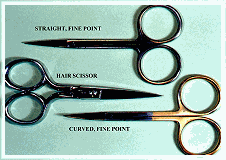 The first scissor you'll need is one with small, fine points
designed to cut thread and fine materials. This should
be one designed for fly tying, not something you found at
the department store. It can have curved tips or straight
ones depending on your desires. The serrated scissors
available from Dr. Slick are excellent scissors that will
last you many years without trouble. Many other companies
offer good scissors too.
The first scissor you'll need is one with small, fine points
designed to cut thread and fine materials. This should
be one designed for fly tying, not something you found at
the department store. It can have curved tips or straight
ones depending on your desires. The serrated scissors
available from Dr. Slick are excellent scissors that will
last you many years without trouble. Many other companies
offer good scissors too.
Another scissor you'll want to have is a heavy duty one
for cutting hair. This can be any scissors designed for
that purpose like a heavy fly tying scissor or a heavy
hair scissor you might find in a beauty salon or barber
shop. Make sure it's stout enough to handle a heavy bunch
of hair without working loose at the hinge. I also have
an old worn pair of scissors I use
to cut wire and other hard materials.
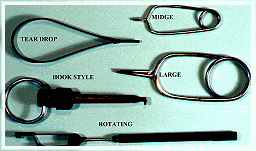
Hackle pliers are small pliers with a constant tension
designed to wrap hackle feathers around the hook. They come in all sizes
and shapes but all perform the same duty. Some even have a swivel head to
make it easy to rotate the hackle around the fly. I manage to find many
uses for these handy tools besides the one they were intended to perform.
If you're limited to one hackle plier, select a midge one since it will do
all the duties of the larger ones, and it will wrap hackles on flies that
are too small for larger hackle pliers.
A bodkin is simply a needle in a handle. You can make your own or buy one
at a fly shop. It has many uses including applying head cement, cleaning
cement out of hook eyes, picking hair out of fuzzy flies and folding
synthetic nymph wings. I'm sure you'll find dozens of other uses, so it's
nice to have a couple of these handy tools around when you're tying flies.
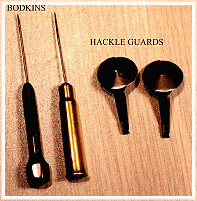
Hackle guards are designed to hold the hackle back from the hook eye when
you tie the finish knot (called a whip finish) on the head of the fly. You
can tie flies without them, but they sure are handy on small flies or flies
with heavy hackle.
Hair stackers are designed to align the tips of hair you're using for
wings, heads and tails. They come in a variety of sizes from very small
(used on small hair wings and tails) to very large (used on large clumps of
hair when spinning hair heads on bass bugs). It's nice to have a variety
of these things, but if you can afford only one, get a medium sized one
since it will do most of the stacking you need to do.
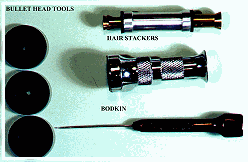
Bullet head tools help make bullet heads on flies like
the Madame X and the Henry's Fork Hopper. You might
be able to perform this task without a special tool,
but they sure make a hard job easy if you have them.
Next week we'll look at whip finishers. These are
tools that make the neat knot at the head of the fly.
Surprisingly, a lot of fly tyers never learned how
to use some of these tools, especially the whip finisher.
~ Al Campbell
Beginning Fly Tying Archives
|
